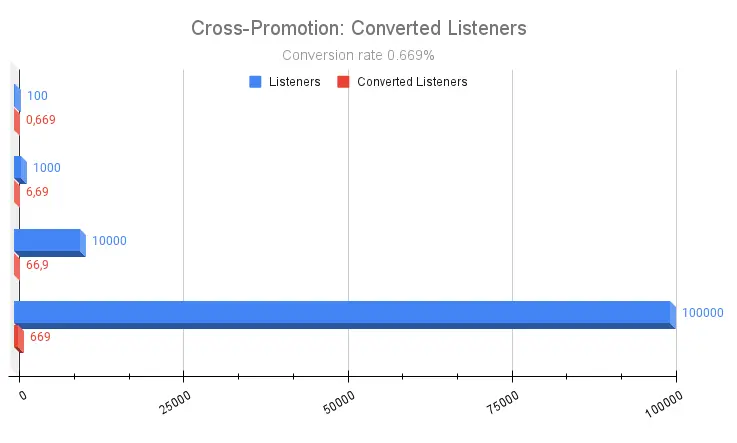
How to Make Your Podcast Go Viral
24.01.2024
Five Attempts to Create Virality
We hate to break it to you, but making a podcast go viral is very difficult. Here’s a numbered list of what we think is most effective in creating a viral effect. We’ll go into more detail later.
- Cross promotion (0.669% conversion rate)
- Podcast guests or being a guest
According to Chartable, the conversion rate for cross-promotion is 0.669%. This means it is all about scale. If you cross promote with another podcast that has 1000 listeners, you will get 6 or 7 new listeners. If they have 10000 listeners, you will get an average of 67 new listeners. Here’s a chart that shows you what you can expect:

These are really the top two triggers to increase downloads very quickly, but we have comments on them which we will cover in a second. Our list goes on with a bit less exposure but also more achievable.
- Interesting social media content
- Attractive podcast titles, cover art and more
- SEO benefits (website)
So there you have it. Our top five strategies for increasing downloads. But there’s always two sides to every coin. Here’s a more detailed explanation of why you should do each and how you should use them. Cross promotion can have several facets, one of which is the promo swap. A promo swap is when you mention another show in your episode and they do the same for you. Similar to this is an ad swap, but it usually differs in that the content is created by the other podcaster. This can be a recording. It can also be a script that you read.
The last one that falls into this category is feed drop, which is the process of having one of your episodes appear in another show’s RSS feed. You do the same for the other podcaster. So there will be an episode from them in your feed. You can take it out of the feed after an agreed time, or you can leave it there. All three of these ways of doing cross-promotion are great and powerful, with feed drop being the most intrusive.
Pitfalls of Cross-Promotion and Podcast Guests
As great as they are, they shouldn’t be used lightly. To get the most out of this approach, you should find a podcast that is similar to yours. The reason for this is that you both share a similar audience, which makes it more effective to get each other’s show in front of listeners. How weird would it be if you talked about rocket science and the other podcaster talked about growing organic food? That’s not the way to make your podcast go viral. Remember that things like virality are very difficult, if not impossible, to achieve for podcasts.
The second reason you shouldn’t take this lightly is that you’re building a relationship with your listeners. They trust you as a host and don’t want to be treated lightly. Showing them another episode that even you wouldn’t listen to violates that trust. My tip: Find another podcaster who talks about a similar topic that you get along with and figure it out as you go.
A more frequent and easier way to increase downloads is to have guests on your show. The more famous the guest, the better, right? Not quite. Although popularity is great, you are looking for listeners who are interested in your topic and your show, not just that particular guest. The conversion rate (how many of the additional listeners become your listeners) is higher if the guest is also a podcaster with a similar topic. So try to find a guest who is also a podcaster! The downside is that it will take longer to prepare an episode because you will have to spend a lot of time researching your guest. And, of course, you need time to find the right podcaster for your show. Some podcasts have the concept of interviewing guests in their industry because they are experts. That’s a different scenario because it’s part of their show strategy.
Social Media
Social media will always play a role when it comes to virality. I’ve seen videos on YouTube going viral but only a small proportion became subscribers. Now, that was regular social media and not social media done by a podcaster. However, it can happen that an Instagram post, a tweet, or a YouTube video goes viral, and this helps your podcast to get attention. You won’t reach that virality level with a simple post about an episode, but you need to put more effort into it. We’ve seen that content which is highly personal (be it a personal story or a person’s face within the video) tends to perform better as a basis for a viral post. In the end, you can’t predict how a post will turn out, and you need to experiment with them.
However, as I mentioned in the beginning, even if you have viral content for your podcast, do not expect everyone to listen to it as well. There’s a difference between viewing and liking content that’s very short and a 30-50-minute podcast.
Long-term Strategies
We are entering the realm of long-term strategies, which include an appealing podcast, regular social media content, and SEO advantages. I’ll make this short because I explain it in more detail in How to Do Podcast Marketing with LemonSpeak. Making a podcast appealing includes a great cover image, intriguing episode titles, and show notes that contain helpful information. Consistency is important in social media, so publishing regularly on the platform of your choice should be a must (30% of new listeners find shows through social media).
Lastly, SEO. It is mostly neglected, even though 17% of new listeners find shows they are interested in through the internet. By SEO, I mean having your own domain and website on which you list your episodes along with the transcript and blog posts. That’s how you provide fuel for a search engine to index your site and show it to people who search for podcasts with your topic. LemonSpeak covers the long-term strategy. You can sign up for a free trial here: Get started for free.